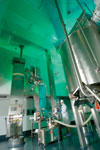November 15, 2008 (Vol. 28, No. 20)
SAFC Charts Course to Compete in a Rapidly Evolving R&D and Healthcare Environment
Although the current global financial turmoil will naturally have an impact on the biopharmaceutical industry, SAFC, the custom manufacturing and services group within the Sigma-Aldrich Group, intends to keep, and even enhance, its position as leading supplier, according to Frank Wicks, Ph.D., president of SAFC.
Recently SAFC Pharma initiated a $30 million expansion of its Madison, WI, facility that will increase its capacity for production of commercial-scale high potency active pharmaceutical ingredients (HPAPIs). The new 45,000-sq-ft manufacturing facility containing commercial reactors will be capable of producing HPAPI batches of up to 4,000 liters, Dr. Wicks explained.
SAFC believes that there will be robust, long-term growth in the healthcare sector given that the world’s population is getting both older and wealthier. For instance, the middle class in emerging economies is set to triple by 2030, led by India and China. The global economy is shifting east, Dr. Wicks said, with emerging economies now growing four times faster than those in developed countries. The main implication for SAFC’s customers is that Asia is a critical marketplace—not just a place for cheap outsourcing.
Another trend is an increase in environmental concerns. “Sustainability in general is becoming a bigger issue on a global basis,” Dr. Wicks observed. Customers are demanding environmentally friendly solutions, and SAFC has a person dedicated to the issues of sustainability, chemistry, and site footprint, he reported. One recent development was the introduction of continuous processing (a flow-based system that uses less energy) rather than batch.
Dr. Wicks also predicted important structural changes in big pharma. The industry is set to lose $55 billion over the next five years as key patents expire. “All pharma companies are facing this, so they are all looking for new drugs and doing a lot more licensing,” he said. “The age of the blockbuster has disappeared. There are more $200 million rather than $1 billion compounds coming through.”
“The maturation of biotech has had a huge impact for us as a business,” explained Archie Cullen, vp sales and marketing. “A lot of small molecule companies like Pfizer and Bristol Myers Squibb are moving aggressively into the biologics space.” Big pharma is working to reinvent itself by getting into biopharm, in its drive for improved innovation productivity, he added. Thus the increasing collaboration of pharma with biotech and academia is likely to continue. According to Dr. Wicks, SAFC is looking for and exploiting niche technologies that will help its customers capitalize on opportunities across both biologics and traditional chemistry.
The uncertainty of the global economy has created a number of challenges for SAFC: the U.S. economic recession, price increases of raw materials (SAFC has seen a 5–10 percent increase in raw materials costs), increased energy costs, finite natural resources, and significant shifts in relative currency strengths. “I sense we are all in for some major adjustments,” Dr. Wicks commented.
Indeed, SAFC has noticed that customers are facing and making tougher decisions about which clinical projects they will fund. Delays in biopharma spending and cancellations of pharma projects have also been occuring of late.
A signficant industry issue is healthcare costs. The U.K.’s National Institute of Health and Clinical Excellence pointed out that there is also an increased focus on personalized medicine because the average effectiveness of new drugs tends to be small. That creates the need for a compound to have greater impact within sub-populations. Those trends support a growing interest in biomarkers for identifying such sub-groups, which leads to codevelopment of diagnostics and new therapies. Meanwhile, increasing globalization provides an opportunity to expand the markets for novel therapies.
“One of the most amazing changes in the last five years has been the increase in speed of development,” said Cullen. “Previously, it would take about a year to get from a gene of interest to a master cell bank. Now the time for leading-edge companies is about 14 weeks and that is revolutionizing the industry. There are therefore more molecules coming through the pipeline.” Miniaturization is also becoming increasingly effective, and disposables and customized cell lines are becoming more popular.
These drivers are changing customer requirements, and the expectations of raw material suppliers like SAFC Biosciences. “We want to support the whole continuum, and we are aware that what the customer wants in preclinical is not relevant to manufacturing,” explained Cullen.
Suppliers are expected to be masters of raw materials, knowing about origins, specifications, applications, and implications. Technologies around clone development, master cell bank, expression, and purification are tightly managed by the customer. “They do not want us to actually engage in the genetic expression systems around protein expression,” Cullen said.
In the later stages of manufacture, customer demands center around cGMP compliance and operational efficiency. Innovation is less important. “Once you have the drug on the market, a key goal is to avoid process changes,” Cullen said.
SAFC Biosciences has responded to changing customer demand by shifting to a customer-intimate model in which the company collaborates with select patrons to provide complex, customized, and integrated solutions. It is also transitioning from cell culture to being a leading raw material supplier, with an increased emphasis on customer pipeline and project acquisition.
“There are a lot of different masters to be served. We are managing across functions and across different phases,” said Cullen. In process development, the company has put together a scale-up model to provide flexible, consistent solutions to timelines. “This is not so much about the sub-elements of the solution,” said Cullen, “it is about the ability to put them together in a way that adds value to drug developers and producers.”

SAFC Biosciences is working with select customers to provide complex, customized, and integrated solutions.



